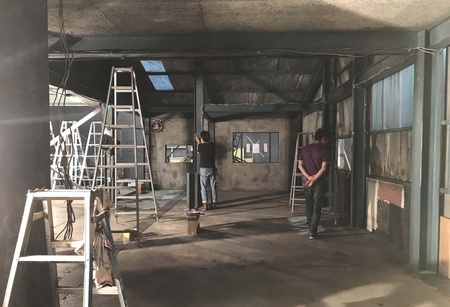Obtained an O visa after studying abroad
In the summer of 2023, when I went to see Hollywood movies like "Oppenheimer" and "Barbie," the trailer for "Gran Turismo" was playing. The trailer made it clear that this was a major production, and Katsuya Imai was involved in the film as a set designer. In the film world, art staff, including set designers and art directors, "are people who design the world view and sets of the work, and are similar to architecture and interior design."
After graduating from Nihon University College of Art in 2008, Imai worked as an art staff member on numerous films and TV dramas, including those by up-and-coming directors such as Koreeda Hirokazu and Kudo Kankuro. In 2014, he went to Los Angeles to study the language, spending a year and a half learning English.
"When I was a child, movies meant Hollywood movies, and I wanted to work in Hollywood someday. My dream of working in the film industry came true (in Japan), so what should I do next to make my dream of working in Hollywood come true? I wanted to be able to speak English, so I came to Los Angeles before I turned 30. When I visited a film studio there, I felt a strong desire to work there rather than just be a student."
He then began taking steps to obtain an O visa for skilled work, but, "to my surprise, my lawyer disappeared halfway through, so I was unable to obtain the visa and returned to Japan. I was introduced to an immigration lawyer with experience in the Hollywood industry, and after requesting his help from Japan, I was finally able to obtain an O visa in 2018," he recalled.
What are the differences between the workplace in Japan and the US?
It has been five years since he moved to Hollywood, and he has been involved in over 30 productions as an art director, including commercials. It seems like a very smooth start, but Imai says that while he was "lucky," it is also because "connections with people are the key."
"They were shooting in Japan for the Netflix film 'Earthquake Bird', with art direction by Yohei Taneda, who is also famous for his work on 'Kill Bill', and they needed art staff who could speak English, so they asked me to help. I was also in charge of building sets and filming in Los Angeles as additional filming. That's when I made connections with people in the industry in Hollywood. I was introduced to other people, and when I did work for them, they introduced me to more people, and so I continued to get requests for work."

So, having actually worked on art direction for films in Hollywood, what do you think are the differences between the Japanese film industry and the work itself?
"First of all, in Hollywood, many people are involved in one production. There is a big difference in the budget, but it costs more to hire people in the US, and because there are unions, there are strict rules when it comes to hiring. Another characteristic is that work is divided into small roles, with this person doing this job and another person doing another job, and working hours are set at eight to 10 hours a day. This also has the advantage that people can concentrate on the work they've been assigned. In the Japanese film industry, it's not uncommon for staff to stay up all night, and they have to do everything from drawing blueprints and pictures to actually managing the construction of the sets."
As a Japanese person, I cannot let my guard down.
When asked if he had gotten used to working on a Hollywood set, Imai replied very humbly:
"It's only been five years, so I'm getting used to it, but I need to work harder so I can hold my head up higher and say, 'I understand it all.'"
Still, has working in Hollywood brought about some kind of inner change?
"What's changed in Hollywood is that I've developed a sense of gratitude. In Japan, being able to work is something that's taken for granted. But here in Hollywood, I'm very grateful that I even have a job, and a sense of gratitude naturally arises in me. I'm also grateful for the connections I have with the people who create that work. I can really feel that I'm being helped by a lot of different people."
He also said it has changed his view of Americans.
"When I was in Japan, I assumed Americans were careless (laughs). That was the image I had, but when I came here, I was surprised at how diligent everyone was in their work and how serious they were. For example, they paid attention to the texture of the walls in the art sets and other details, and I was honestly amazed at how carefully they worked. It made me realize that as a Japanese person, I can't let my guard down."
And Imai's ultimate dream is to win an Academy Award.
"The people in Japan tell me to come back anytime, but now that I've come here I don't intend to go back until I've achieved success. I want to be involved in films that will go down in history and win an Academy Award. But to do that, it's essential that I work carefully on each project and cherish my connections with people."
Imai-san reportedly married an American woman in 2022. "I'm a shy person, but I couldn't suppress my feelings for her," he said. With his straightforward personality and inner passion, he is sure to continue to be active in the Hollywood film industry.
© 2023 Katsuya Imai






